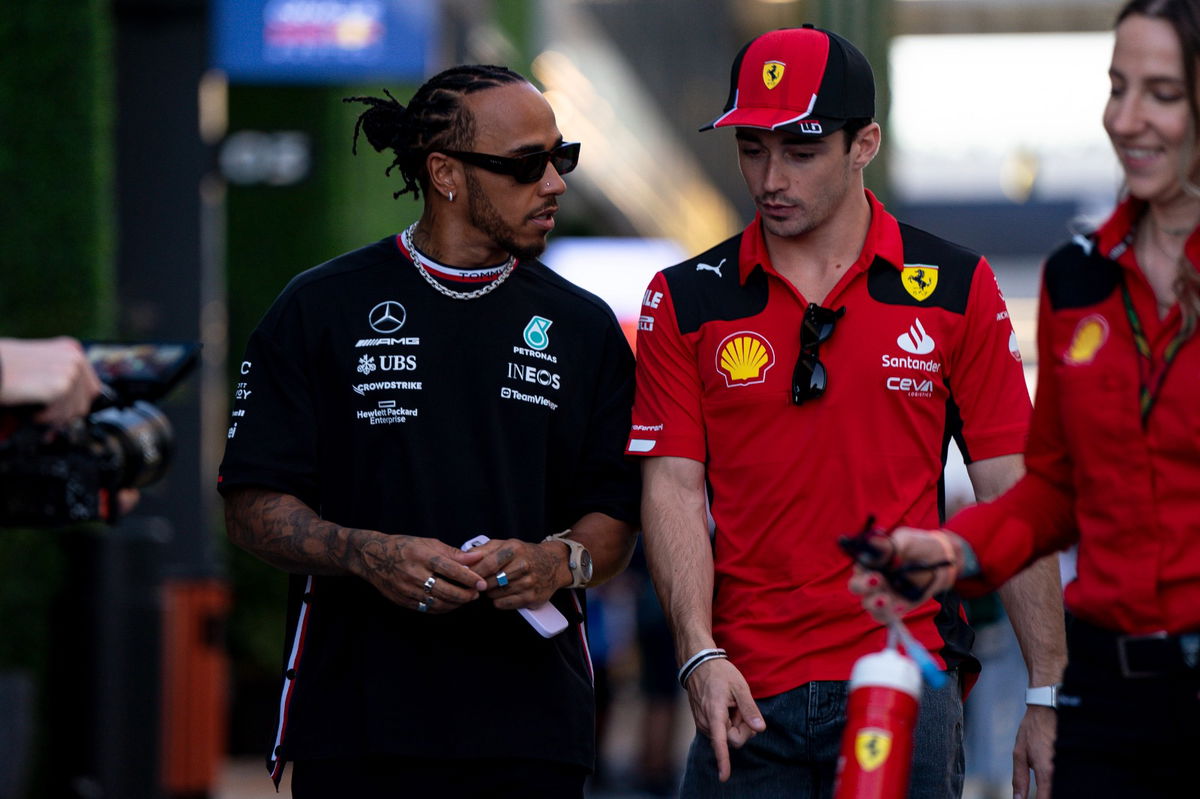
Imago
March 16, 2023, Jeddah, Saudi Arabia: LEWIS HAMILTON of Great Britain and Mercedes-AMG F1 Team and CHARLES LECLERC of Monaco and Scuderia Ferrari are seen in the paddock during preparations of the 2023 FIA Formula 1 Saudi Arabian Grand Prix at Jeddah Corniche Circuit in Jeddah, Saudi Arabia. Jeddah Saudi Arabia – ZUMAg147 20230316_zap_g147_022 Copyright: xJamesxGasperottix

Imago
March 16, 2023, Jeddah, Saudi Arabia: LEWIS HAMILTON of Great Britain and Mercedes-AMG F1 Team and CHARLES LECLERC of Monaco and Scuderia Ferrari are seen in the paddock during preparations of the 2023 FIA Formula 1 Saudi Arabian Grand Prix at Jeddah Corniche Circuit in Jeddah, Saudi Arabia. Jeddah Saudi Arabia – ZUMAg147 20230316_zap_g147_022 Copyright: xJamesxGasperottix
As we all know, the mega effort by Lewis Hamilton and Charles Leclerc in Austin during the 2023 US GP was all undone thanks to the post-race disqualification. Through no fault of their own, the two F1 stars faced disqualification because of non-compliance with one of FIA’s regulations under Article 3.5.9. Ever since the announcement, the entire world has been waiting for additional information about the post-race scrutineering procedures and we finally have them.
Watch What’s Trending Now!
The FIA has a host of technical directives and regulations that all teams must adhere to during a race weekend. These regulations are implemented to ensure no team gains a competitive advantage while compromising on the high safety standards set by the governing body. However, due to the limited time, especially during back-to-back race weekends, the FIA’s technical team picks the teams, cars, and components they want to check randomly throughout the weekend.
#FIAInsights🔍 – How does the FIA go about checking for compliance, and is it the same at every event? The answer is that a series of random checks are carried out every weekend on different areas of the cars – full story belowhttps://t.co/TSgwpMQiDF
— FIA (@fia) October 26, 2023
ADVERTISEMENT
This practice, which has been in place for decades, keeps all teams on their toes and compliant with the technical directives every race weekend. These checks are separate from the fuel sample check post every Grand Prix and not every component is checked every time due to the time crunch. To help with an informed selection of the component to be checked, even if it’s at random, the technical team has a plethora of data from various sources and the sensors in the cars.
So in Austin, the technical team picked four cars for the plank check, including the W14 of Hamilton and the SF-23 of Leclerc. Clearly, only the Mercedes and Ferrari challengers failed the tests which the FIA’s technical team informed the stewards about, which later resulted in the disqualification.
ADVERTISEMENT
However, the vast majority of the time, the teams are in compliance, which is why we hardly come across post-race disqualifications. Although Mercedes and Ferrari ran out of luck in Austin. We are sure you’re wondering if Hamilton and Leclerc could’ve gotten away with it and we have an answer for you.
ADVERTISEMENT
Could Lewis Hamilton and Charles Leclerc have escaped the 2023 US GP disqualification?
The simple answer is yes! The four cars picked at random could’ve been very easily the cars of their teammates or from different teams altogether. These random checks have a lot of constraints, which is exactly why they’re done at random and on limited cars. Let’s look at the challenges the technical team faces that could’ve made the two disqualified cars get a free get-out-of-jail card.

Imago
March 16, 2023, Jeddah, Saudi Arabia: LEWIS HAMILTON of Great Britain and Mercedes-AMG F1 Team and CHARLES LECLERC of Monaco and Scuderia Ferrari are seen in the paddock during preparations of the 2023 FIA Formula 1 Saudi Arabian Grand Prix at Jeddah Corniche Circuit in Jeddah, Saudi Arabia. Jeddah Saudi Arabia – ZUMAg147 20230316_zap_g147_023 Copyright: xJamesxGasperottix
The random checks, as the name suggests, do not cover every component of every car after every race weekend. A huge amount of work goes into conducting these tests. So the technical team has a limited time frame after a race and before the cars need to be returned to teams for disassembly and transportation to the next race.
ADVERTISEMENT
This aspect makes checking every parameter, even on the selected few cars, impossible for the technical team. The checks become more difficult, especially during the back-to-back race weekends like the one in Austin, as freight deadlines are also kept in consideration.
Top Stories
Who Is Oscar Piastri’s Father, Chris Piastri? Co-Founder of Multibillion Dollar Automotive Company

Who Is Lando Norris’ Girlfriend? Everything You Need to Know About Margarida Corceiro

Where Does Max Verstappen Live Stream?

Who Are Lando Norris’s Parents? Meet Adam Norris and Cisca Wauman

Hollywood Star Not Holding Back Against Zak Brown in Lando Norris Championship Fiasco

However, even with this highly complex permutation and combination of regulatory checks and the high probability of getting away with it, Hamilton and Leclerc faced disqualification.
WATCH THIS STORY: Lewis Hamilton Remains Unwavering in his determination to Halt Max Verstappen’s Dominance, Despite Enduring Significant Neglect from the FIA
ADVERTISEMENT
As they say, no one can escape their fate. However, this does not mean good things aren’t coming for the two, especially Mercedes, which showcased an incredible jump in performance in Austin.
Let’s see how the two bounce back in Mexico.
ADVERTISEMENT
ADVERTISEMENT
ADVERTISEMENT

